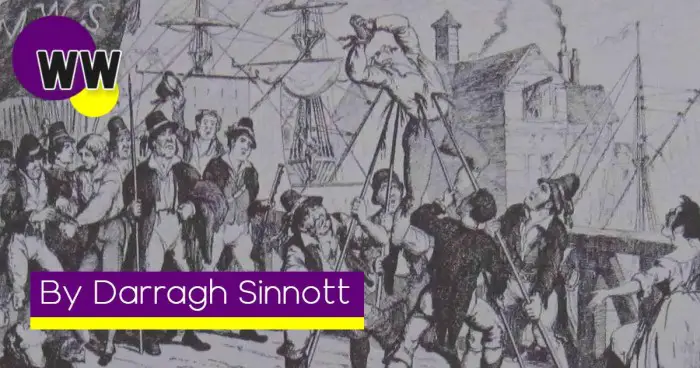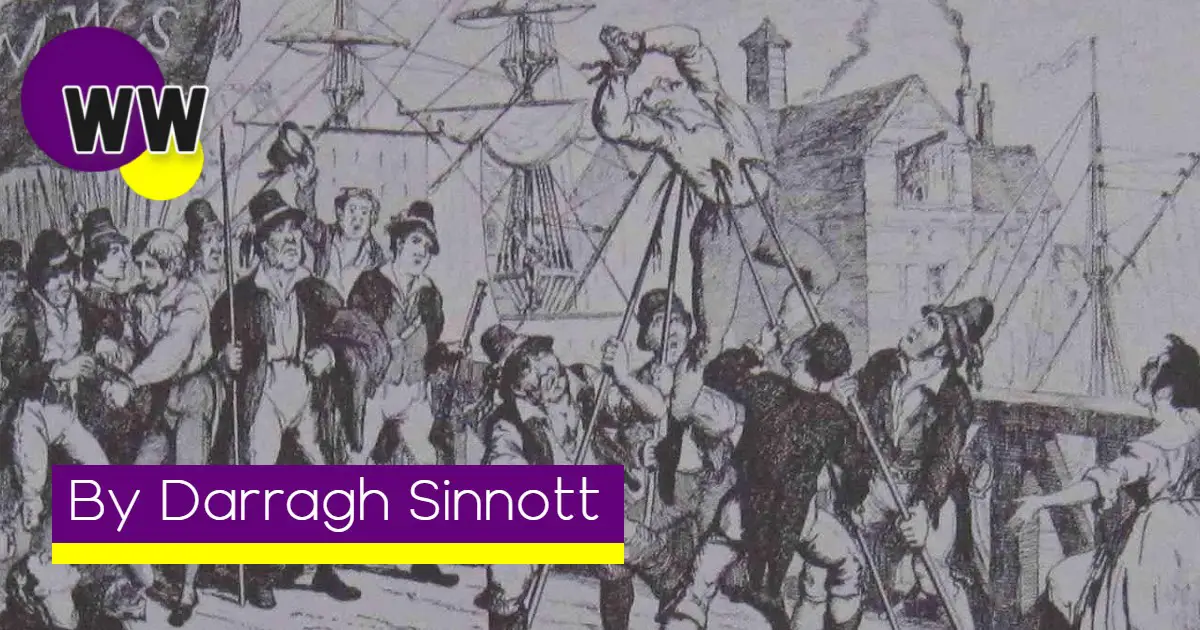Here in Wexford we have a great deal of admiration for the rebellion of 1798 and rightfully so…
For the most part, the rebellion was an explosion of chivalrous, nationalistic ideals which had been absent for far too long in Irish society. Many of those who stood up and fought for the sovereignty of the Irish people and who fought in opposition to the tyranny and cruelty of the British Empire were noble, selfless and just, in fact those descriptors would very aptly describe the vast majority of all those who took up arms against the British Empire.
On a personal level, I greatly admire the rebels and their valiant stand for freedom, yet even I must admit that in history one must be careful not to generalise or to tar all with the one brush.
It is true that near all the commanders of the Wexford Rebellion were honourable and believed firmly in the principles of a free Ireland and a just, egalitarian and humane society where all could live a prosperous and comfortable life.
Beauchamp Baegnal Harvey, General Thomas Clooney, Esmonde Kyan and Fr. John Murphy were all figures who deserve the greatest degree of reverence. Yet some did not share their humanity, some such as Thomas Dixon.
Early life:
Dixon was by no means born into a background of poverty or squalor. Thomas Dixon was born in Castlebridge, Wexford, to parents who were not only millers but who also owned the main pub and shop in the village. In many ways, the Dixon family were at the heart of life in Castlebridge.
Thomas’ father, Nicholas Dixon set up his milling and malting business in 1742 and come 1810 he had amassed so much wealth that not only did he have his milling and malting business, public house and shop, he built the elegant Castlebridge House, which would go on to be the birthplace of the Guinness Book of World Records.
But Thomas did not follow his parents into the milling business, neither did he involve himself with the shop. Instead, he opted to become a sea captain, a profession which many from Wexford would have entered due to its proximity to the sea.
On top of this, he did venture in to the one part of the family business, as he worked as a publican for the family-run pub in the village.
Dixon and the Society of United Irishmen:
The Society of United Irishmen was founded on the 18th of October, 1791 in Belfast. The society led by giants of Irish nationalism such as Theobald Wolfe Tone and Robert Emmet was a society dedicated to a sovereign Ireland free from British Rule.
The society stood for equality between Catholics and Protestants. The Society became incredibly popular and membership spread throughout the country at a rapid pace. It was not long until the British government realised the palpable threat that the United Irishmen posed to their rule and the Society was eventually banned with membership being a criminal offence.
Dixon became associated with the organisation through his marriage to Margaret Roche. Margaret’s brother Edward was highly regarded in the Society of United Irishmen, so much so that he held the post of General and he was most likely the one that recruited Thomas into the organisation.
Proclamation of the Wexford Republic:
After the tremendous defeat of British forces at the Battle of the Three Rocks by rebel forces under General Thomas Cloney, the British garrison in Wexford town fled leaving the town virtually undefended. General Edward Roche led the rebel forces which took the town and was appointed Governor of the Wexford Republic.
Following the taking of the town, 260 Protestants were jailed in Wexford town. Cruel as this may sound, it was done to protect the protestant population. The moderate rebel leaders understood a town of oppressed people who had cast off their shackles would now be filled with rebellious fervour and may have been liable to act rashly.
These jails, established for the protection of those imprisoned, were situated across the town, with Wexford Jail (which was located on South Main Street), the Market House (now Wexford Art’s Centre), the Courthouse (which at the time was situated in the Bullring) and a prison ship were being used to hold the detainees.
The moderate leaders were compassionate and wished to see peaceful order restored to the town, yet among their ranks, some of the best generals of the rebel forces were to be found. Thomas Cloney, Baegnal Harvey, Edward Roche and Esmonde Kyan all decided that they were of more use on the Battlefield than in the town and so departed for battle.
It is notable that Dixon did not choose to gallantly follow his comrades into the fray and the danger of battle. Instead, with other extremists, he stayed in the town and along with his wife Madge unleashed the full extent of his vindictive nature onto civilians in the town.
Dixon’s terror begins:
Now with the town under rebel control Dixon was emboldened by the lack of order and was free to unleash the full extent of his cruelty and inhumanity. It is clear from the reaction of all other rebel commanders, this campaign of horror was in no way approved by the leadership of the Wexford Republic, and in fact, it was abhorred.
It must be said Dixon was a mere leader of a riled up mob and not representative of the rebellion or the Wexford Republic, but nonetheless, the malicious punishment he inflicted on loyalists and protestants in the town is worth exploring as among the darkest chapters of the 1798 rebellion.
It would be easy to chalk Dixon’s actions down to a sectarian hatred which had festered for years as the Protestant ascendancy and British aristocracy lauded over the Catholic and Irish majority. Dixon must have believed that because the British authorities no longer held sway no one would attempt to put an end to his vengeful and twisted plans. The extent of this violence is nearly too much to chalk down to mere divisions in society and bitterness; it is clear that there was a personal element to Dixon’s actions.
It was said that his wife Margaret had been raped by a British soldier at the outbreak of the rebellion. This would have understandably made Dixon beyond furious and would have instilled in him a murderous rage. Nonetheless, what Dixon was about to inflict on some of the loyalist and Protestant population of the town was simply inexcusable.
The death of Francis Murphy:
One of the most notable incidents of Dixon taking vengeance for an issue deeply personal to him came in the form of his killing of Francis Murphy.
Francis Murphy, who was an employee of the Edward’s household in Rathaspeck, accused Father Thomas Dixon of trying to recruit him into the Society of United Irishmen in a tavern in Wexford.
Aside from being a curate in Blackwater, Fr. Dixon was a cousin of Thomas Dixon. To add to Dixon’s fury, his cousin had been sent to Duncannon Fort to await his deportation and while on board a ship there he perished.
Dixon held Murphy fully responsible for the death of his cousin and intended to make him pay the full price for his betrayal of Fr. Dixon. Following the establishment of the Wexford Republic, Dixon had Murphy dragged out into the Bullring and shot. His body was dragged from the Bullring to the Quay where it was unceremoniously dumped into the waters below. In comparison to the others who would suffer Dixon’s wrath, Murphy’s death was much quicker and much more painless than what was to be inflicted onto some.
Massacre on the bridge:
Dixon and his wife Madge incited a murderous hatred in many in the town and even went as far as to call for the razing of the prison which would have led to the painful death of those who remained there. Yet Thomas’ infamy was not earned by mere threats to murder prisoners. Thomas and Madge together established a systemic method of trying and condemning Protestants and loyalists in the town.

The actions of Dixon and his followers were in no way carried out on the spur of the moment; it was clear Dixon had meticulously planned for the events that were to come.
On the 20th of June 1798, Dixon and his followers marched across Wexford Bridge from the Ferrybank side with an ominous black flag with a large red cross on one side and on the other side in white paint the letters M.W.S. had been painted. These letters were an acronym and stood for Murder Without Sin. This suggests that Dixon and his mob believed themselves to be on a crusade of sorts and were exonerating themselves from punishment divine or otherwise for the act they were about commit.
Dixon made sure the mob was inebriated with an excess of whiskey before they made their way to the jail showing just how well planned Dixon’s atrocity was. They then proceeded to the various jails and dragged prisoners from them. These prisoners were dragged before a kangaroo court of seven less than unbiased judges in the Billiard Room on the Custom House Quay. They were all inevitably found guilty.
Loyalists and Protestants found guilty were marched under the black banner to Wexford Bridge where a gruesome fate awaited them. They were greeted by four Pikemen who first knelt in prayer and prayed for God’s blessing before carrying out their executions. Two rebels would push their pikes into the victims back and two into their chest and would some suspend him. As one would imagine, this would have caused the prisoner to howl in agony and their suffering was only ended when they were then dropped into the River Slaney.
This sort of conduct did not represent the heroism and gallantry of the rebellion. The actions of the pikemen on the bridge did not represent the valour and honour displayed by pikemen on the battlefield and throughout the county. This was merely the cowardly actions of a cruel man and his wife.
This is very clearly illustrated as when news reached Dixon’s brother in law and governor of the Wexford Republic, General Roche, and Esmonde Kyan, who was the commander of the North Wexford rebel army.
They rushed back to the town to put an end to the barbarity.
On the 21st of June, they reached the bridge and they managed to put a halt to the executions and spared the lives of many prisoners. Parish Priest of Wexford Canon John Corrin had reached the bridge and found six men hanging and managed to secure the release of some prisoners.
Yet the humanity of Roche, Kyan and Corrin displayed had come too late for some as it was estimated anywhere from 97 to over 100 loyalists and protestants died at the hands of Dixon and his mob. 37 were said to have been executed on the bridge. Dixon earned the nickname ‘Bloody Job Dixon’ but was not around to see due punishment for his crimes. When his atrocities at the bridge were uncovered, he fled with his wife Madge.
There were reports of his attendance at a council of war on the 9th of July and of his part in a rebel army in Meath on July 13th.
Following the fall of the Wexford Republic, the British Army matched and exceeded the cruelty of Dixon as they executed the gallant and honourable rebellion such as Esmode Kyan, Baegnal Harvey and John Kelly on Wexford Bridge. General Edward Roche perished in jail.
Thomas and Madge Dixon never faced punishment for their crimes and evaded capture.
What is the purpose of writing this article? I can assure you it is not to tarnish the legacy of ’98. As a journalist, I will admit my biases as being fervently in favour of the United Irishmen rebellion of 1798 and supportive of their ideas. Even as ardent a supporter of the rebels of ’98, I must admit that no rebellion is without its cruel streak and ’98 was no different.
The story of Dixon defies the black and white narrative which history is so often viewed through. It shows that even in the ranks of the rebels there lay tyrants.
Sources:
Famous Wexford People in History, Des Kiely, Parsifal Press, 2018
AN IRISHMAN’S DIARY (irishtimes.com)
Read also:
Remember to submit your news to Wexford Weekly! To advertise on our socials or website, email our team at info@wexfordweekly.com


